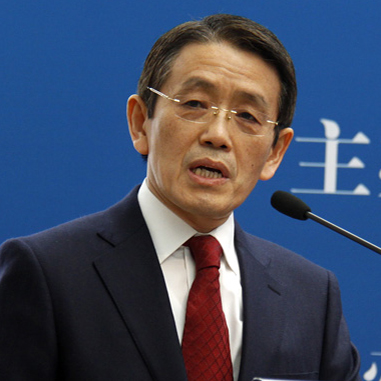Past Events
Your Present Location: EVENTS> Past EventsThink Tank Report: 2025 Could Mark the First Year of a U.S. Debt Collapse U.S. Sovereign Credit at Risk as Trump's Second Term Sparks Economic Alarm

Symposium Held in Beijing Ahead of Trump’s 100 Days
On April 28, on the eve of the first 100 days of Trump’s second term, the Chongyang Institute for Financial Studies at Renmin University of China (RDCY) hosted a report launch and symposium on U.S. Sovereign Credit and Debt Crisis in Beijing. Prominent experts and scholars from universities, financial institutions, and research organizations participated in the discussions.
During the event, RDCY released the research report U.S. Sovereign Credit and Debt Crisis: A Ponzi Scheme on the Brink of Collapse? The report offers an in-depth analysis of the causes and current state of the U.S. debt problem and its potential risks to global economic trade and financial stability. It evaluates whether Trump’s second-term policy measures can effectively mitigate fiscal imbalances, safeguard the dollar’s status, and sustain American economic growth. In the context of intensified U.S. pressure on China and rising policy uncertainty, the report also proposes suggested measures for China to address the U.S. debt trap and Trump 2.0’s governance turbulence.
U.S. Debt Crisis Accelerating: 2025 at a Tipping Point
The report points out that the U.S. is heading toward an explicit sovereign credit crisis, with 2025 potentially marking the onset of a debt collapse. Within the first three months of Trump’s second term, policies such as “reciprocal tariffs” and extreme fiscal austerity triggered a sharp rise in one-year inflation expectations to 4.3%, a two-year high, while consumer confidence plummeted to 67.8, down 11.8% year-on-year.
Trump’s tax policies are projected to expand the baseline fiscal deficit by $5.8 trillion over the next decade. Extending tax cuts and slashing federal aid programs would impose an annual net loss of $1,125 on the bottom 20% of earners while rewarding the top 1% with an average annual gain of $43,500.
Financial Market Turmoil Marks Start of “Trump Crash”
The report highlights that Trump’s reckless governance has dealt a severe blow to U.S. credit, resulting in the largest one-day drops of U.S. stock market in nearly five years, a 40-basis-point spike in 10-year Treasury yields within three days, and a cumulative decline of over 10% in the dollar index. This triggered a simultaneous collapse in the U.S. stock, bond, and currency markets, signaling the start of the “Trump Crash.”
The loss of government credibility, compounded by policy inconsistency and unilateralism, has triggered widespread panic. Predictions of a financial crisis akin to 2008 are rampant, with forecasts suggesting a greater than 50% chance of a U.S. recession in 2025. Trump’s net approval rating fell sharply from +2% in mid-March to -10% by mid-April. The resulting financial instability exposed vulnerabilities in the dollar system, sparking global capital flight, plunging U.S. Treasury prices, and pushing gold to historic highs.
Is the U.S. Debt Ponzi Scheme on the Brink?
According to the report, the U.S. debt situation is showing characteristics of a Ponzi-like structure and is approaching a critical point, posing major risks of economic and social breakdown. U.S. federal debt has reached $36.2 trillion, accounting for 123% of GDP—well above the 60% international warning threshold. External debt stood at approximately $26 trillion in 2024, and net international investment position fell to around -$26.2 trillion. U.S. debt reliant on rolling over debt at unsustainable levels. In fiscal year 2025, about $9.3 trillion of publicly held debt is set to mature, accounting for one-third of the total, while debt growth far outpaces the economy’s carrying capacity. Federal interest payments reached $882 billion in fiscal year 2024, a 33.7% increase year-on-year, surpassing military spending for the first time. Interest payments are projected to climb another 8% in 2025, reaching $952 billion.
Over the next decade, cumulative interest payments could reach $13.8 trillion—nearly double the inflation-adjusted total over the past two decades. By 2050, the federal debt-to-GDP ratio is forecast to rise to about 166%. Publicly held U.S. federal debt is projected to rise from 100% of GDP in 2025 to 118% by 2035, surpassing the previous 80-year high of 106%. At the same time, Trump’s second-term policy mix of external tariffs + internal tax cuts is inherently contradictory: tariffs are expected to push inflation close to 5%, while fiscal tightening will exacerbate social inequality. The failure of U.S. government policies is accelerating the collapse of U.S. debt credibility. International credit rating agencies have issued warnings of a potential downgrade of U.S. sovereign debt, and global capital markets are experiencing severe turbulence, with skepticism about the sustainability of dollar hegemony reaching historic highs.
Dollar System Faces Historic Decline
The report states that global “de-dollarization” is underway, with Wall Street’s dominance facing historic erosion. Global central banks continue to reduce their holdings of U.S. Treasuries. By the third quarter of 2024, the dollar’s share of global official reserves had dropped to 57.4%, the lowest in 30 years.
Meanwhile, gold, the renminbi(RMB), and other emerging currencies are on the rise. As of February 2025, central banks in Poland, China, Turkey, and others had made net purchases of 24 tons of gold. China’s central bank alone purchased 5 tons, marking four consecutive months of net buying. Spot gold prices surged to a record high of $3,500 per ounce on April 22.
The BRICS nations are exploring resource-backed currencies, over 130 countries are pushing forward with central bank digital currency projects, and cross-border settlement systems are undergoing rapid restructuring. The combined collapse of stocks, bond sell-offs, and dollar depreciation forms a “death spiral” undermining Wall Street’s financial hegemony. Cryptocurrencies and the digital renminbi are disrupting traditional dollar settlement networks, rendering the “dollar smile theory” obsolete, and ushering the global monetary system toward a multi-polar future.
A New Global Order Emerging
The report warns that Trump’s “reciprocal tariffs” strategy, aimed at revenue extraction without restraint, risks turning the U.S. into a pariah state. Trump’s second-term tariff measures surpass even the infamous 1930 Smoot-Hawley Tariff Act, threatening to cause an unexpected contraction in global trade and economic activity.
Short-sighted populist policies could lead the U.S. down the path toward another Great Depression. However, the report stresses that the collapse of the U.S. debt system will not signal the end of the global financial order. Rather, 2025 will mark the beginning of a long, gradual reconstruction of global credit systems. As U.S. hegemony fades, a new order of cooperation and mutual benefit, led by emerging economies and a multi-polar monetary system, is set to take shape.
Key Words: U.S., Trump, Second Term, Economic Alarm























































































 京公网安备 11010802037854号
京公网安备 11010802037854号





